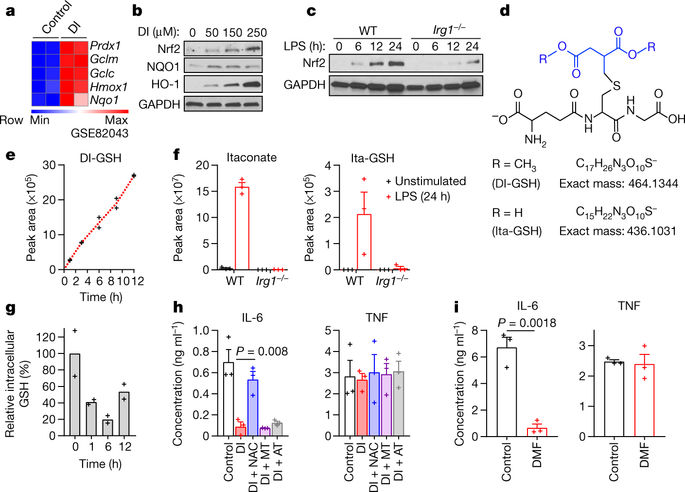Our official English website, www.x-mol.net, welcomes your
feedback! (Note: you will need to create a separate account there.)
Electrophilic properties of itaconate and derivatives regulate the IκBζ–ATF3 inflammatory axis
Nature ( IF 50.5 ) Pub Date : 2018-04-01 , DOI: 10.1038/s41586-018-0052-z Monika Bambouskova 1 , Laurent Gorvel 1 , Vicky Lampropoulou 1 , Alexey Sergushichev 2 , Ekaterina Loginicheva 1 , Kendall Johnson 3 , Daniel Korenfeld 1 , Mary Elizabeth Mathyer 4 , Hyeryun Kim 3 , Li-Hao Huang 1 , Dustin Duncan 5 , Howard Bregman 3 , Abdurrahman Keskin 6 , Andrea Santeford 7 , Rajendra S Apte 7 , Raghav Sehgal 8 , Britney Johnson 1 , Gaya K Amarasinghe 1 , Miguel P Soares 9 , Takashi Satoh 10 , Shizuo Akira 10 , Tsonwin Hai 11 , Cristina de Guzman Strong 4 , Karine Auclair 5 , Thomas P Roddy 3 , Scott A Biller 3 , Marko Jovanovic 6 , Eynav Klechevsky 1 , Kelly M Stewart 3 , Gwendalyn J Randolph 1 , Maxim N Artyomov 1
Nature ( IF 50.5 ) Pub Date : 2018-04-01 , DOI: 10.1038/s41586-018-0052-z Monika Bambouskova 1 , Laurent Gorvel 1 , Vicky Lampropoulou 1 , Alexey Sergushichev 2 , Ekaterina Loginicheva 1 , Kendall Johnson 3 , Daniel Korenfeld 1 , Mary Elizabeth Mathyer 4 , Hyeryun Kim 3 , Li-Hao Huang 1 , Dustin Duncan 5 , Howard Bregman 3 , Abdurrahman Keskin 6 , Andrea Santeford 7 , Rajendra S Apte 7 , Raghav Sehgal 8 , Britney Johnson 1 , Gaya K Amarasinghe 1 , Miguel P Soares 9 , Takashi Satoh 10 , Shizuo Akira 10 , Tsonwin Hai 11 , Cristina de Guzman Strong 4 , Karine Auclair 5 , Thomas P Roddy 3 , Scott A Biller 3 , Marko Jovanovic 6 , Eynav Klechevsky 1 , Kelly M Stewart 3 , Gwendalyn J Randolph 1 , Maxim N Artyomov 1
Affiliation

|
Metabolic regulation has been recognized as a powerful principle guiding immune responses. Inflammatory macrophages undergo extensive metabolic rewiring1 marked by the production of substantial amounts of itaconate, which has recently been described as an immunoregulatory metabolite2. Itaconate and its membrane-permeable derivative dimethyl itaconate (DI) selectively inhibit a subset of cytokines2, including IL-6 and IL-12 but not TNF. The major effects of itaconate on cellular metabolism during macrophage activation have been attributed to the inhibition of succinate dehydrogenase2,3, yet this inhibition alone is not sufficient to account for the pronounced immunoregulatory effects observed in the case of DI. Furthermore, the regulatory pathway responsible for such selective effects of itaconate and DI on the inflammatory program has not been defined. Here we show that itaconate and DI induce electrophilic stress, react with glutathione and subsequently induce both Nrf2 (also known as NFE2L2)-dependent and -independent responses. We find that electrophilic stress can selectively regulate secondary, but not primary, transcriptional responses to toll-like receptor stimulation via inhibition of IκBζ protein induction. The regulation of IκBζ is independent of Nrf2, and we identify ATF3 as its key mediator. The inhibitory effect is conserved across species and cell types, and the in vivo administration of DI can ameliorate IL-17–IκBζ-driven skin pathology in a mouse model of psoriasis, highlighting the therapeutic potential of this regulatory pathway. Our results demonstrate that targeting the DI–IκBζ regulatory axis could be an important new strategy for the treatment of IL-17–IκBζ-mediated autoimmune diseases.The immunoregulatory metabolite itaconate and its dimethyl derivative induce electrophilic stress and react with glutathione to induce both Nrf2-dependent and Nrf2-independent responses, resulting in AF3-mediated inhibition of the inflammation-related protein IκBζ.
中文翻译:

衣康酸及其衍生物的亲电特性调节 IκB z–ATF3 炎症轴
代谢调节已被认为是指导免疫反应的强大原则。炎症巨噬细胞经历广泛的代谢重组1,其标志是产生大量衣康酸,最近被描述为一种免疫调节代谢物2。衣康酸酯及其可渗透膜的衍生物衣康酸二甲酯 (DI) 选择性抑制细胞因子 2 的子集,包括 IL-6 和 IL-12,但不抑制 TNF。衣康酸对巨噬细胞活化过程中细胞代谢的主要影响归因于对琥珀酸脱氢酶2,3的抑制,但仅这种抑制不足以解释在DI病例中观察到的显着免疫调节作用。此外,衣康酸和DI对炎症程序的这种选择性作用的调节途径尚未确定。在这里,我们表明衣康酸和 DI 诱导亲电应激,与谷胱甘肽反应,随后诱导 Nrf2(也称为 NFE2L2)依赖性和非依赖性反应。我们发现亲电应激可以通过抑制 IκB z 蛋白诱导选择性地调节对 Toll 样受体刺激的次级转录反应,但不能调节初级转录反应。 IκB z 的调节独立于 Nrf2,我们将 ATF3 确定为其关键介质。抑制作用在物种和细胞类型中是保守的,体内给予 DI 可以改善银屑病小鼠模型中 IL-17-IκBz 驱动的皮肤病理学,凸显了该调节途径的治疗潜力。我们的结果表明,靶向 DI-IκB z 调节轴可能是治疗 IL-17-IκB z 介导的自身免疫性疾病的重要新策略。免疫调节代谢物衣康酸及其二甲基衍生物诱导亲电子应激并与谷胱甘肽反应,诱导 Nrf2 依赖性和 Nrf2 独立反应,从而导致 AF3 介导的炎症相关蛋白 IκB z 的抑制。
更新日期:2018-04-01
中文翻译:

衣康酸及其衍生物的亲电特性调节 IκB z–ATF3 炎症轴
代谢调节已被认为是指导免疫反应的强大原则。炎症巨噬细胞经历广泛的代谢重组1,其标志是产生大量衣康酸,最近被描述为一种免疫调节代谢物2。衣康酸酯及其可渗透膜的衍生物衣康酸二甲酯 (DI) 选择性抑制细胞因子 2 的子集,包括 IL-6 和 IL-12,但不抑制 TNF。衣康酸对巨噬细胞活化过程中细胞代谢的主要影响归因于对琥珀酸脱氢酶2,3的抑制,但仅这种抑制不足以解释在DI病例中观察到的显着免疫调节作用。此外,衣康酸和DI对炎症程序的这种选择性作用的调节途径尚未确定。在这里,我们表明衣康酸和 DI 诱导亲电应激,与谷胱甘肽反应,随后诱导 Nrf2(也称为 NFE2L2)依赖性和非依赖性反应。我们发现亲电应激可以通过抑制 IκB z 蛋白诱导选择性地调节对 Toll 样受体刺激的次级转录反应,但不能调节初级转录反应。 IκB z 的调节独立于 Nrf2,我们将 ATF3 确定为其关键介质。抑制作用在物种和细胞类型中是保守的,体内给予 DI 可以改善银屑病小鼠模型中 IL-17-IκBz 驱动的皮肤病理学,凸显了该调节途径的治疗潜力。我们的结果表明,靶向 DI-IκB z 调节轴可能是治疗 IL-17-IκB z 介导的自身免疫性疾病的重要新策略。免疫调节代谢物衣康酸及其二甲基衍生物诱导亲电子应激并与谷胱甘肽反应,诱导 Nrf2 依赖性和 Nrf2 独立反应,从而导致 AF3 介导的炎症相关蛋白 IκB z 的抑制。











































 京公网安备 11010802027423号
京公网安备 11010802027423号